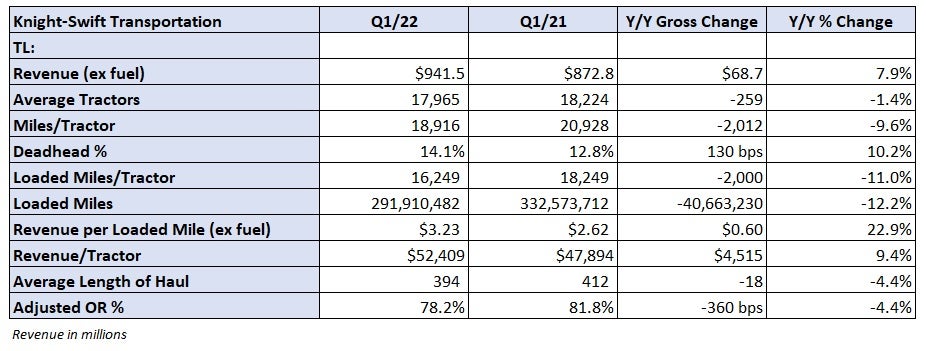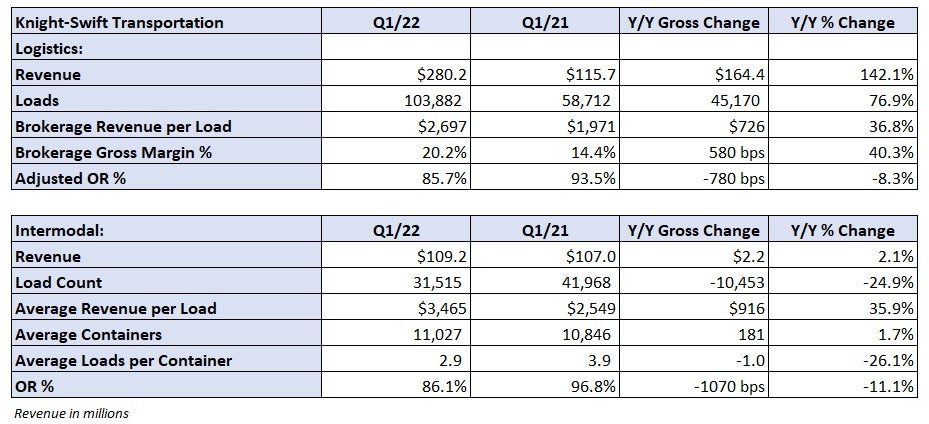On its first earnings call in four years, management from Knight-Swift Transportation laid out a bullish long-term thesis for its business. It believes transportation providers with large trailer pools will continue to be the winners moving forward. The near-term outlook for smaller carriers was less rosy.
Knight-Swift (NYSE: KNX) reported adjusted earnings per share of $1.35 after the market closed Wednesday, 52 cents higher year-over-year and 9 cents ahead of the consensus estimate.
The result included a $13.1 million (8 cents per share) mark-to-market adjustment related to an unrealized loss in its investment in Embark Trucks. However, gains on sale were $34.8 million compared to just $10.5 million in the year-ago quarter. The incremental gains contributed roughly a dime to EPS.

Big to fare better than small
“The reality is equipment is very scarce and has a limited useful life. And we’ve not, as an industry, supplied the industry with enough trucks to really accommodate the aging useful life of equipment,” Dave Jackson, president and CEO, stated on the call.
Original equipment manufacturers, he noted, are coping with production delays, aren’t taking more orders and will be late making deliveries, as they were last year. With less new capacity, big fleets aren’t trading equipment at the same pace, which means small carriers can’t add capacity or must buy at peak prices.
“We’re not enabling small carriers to affordably come in and add capacity,” Jackson said. “The limited number of used trucks we are selling … in some cases we’re selling these for as much or close to what we paid for them brand new before we put 450,000 or 500,000 miles on the trucks.”
The average age of the Knight-Swift’s TL tractor fleet was 2.6 years in the first quarter compared to 2.3 years in the 2021 first quarter.
Jackson predicted smaller operators will have a tough time adjusting to their higher cost profile (increases in expenses like labor, fuel, insurance, equipment, etc.) now that spot rates have declined.
Much of the freight that disappeared in the first quarter was “some of the least efficient freight,” Jackson contends. It was live-load brokered freight, the type small operators thrived on in the spot market for more than 18 months. “It’s stuff that didn’t have commitments and it’s paid at ridiculously high rates and of course that’s going to be the first stuff to go away,” Jackson said.
Knight-Swift ended the quarter with 71,000 trailers, a number it expects to grow by more than 10% in 2022. The company has gained traction in its power-only brokerage offering as customers favor providers with assets and limit load allocations to brokers without them.
“It is a tale of two cities … the traditional old school live load, live unload way that is struggling to grow versus this [power-only] that we almost can’t slow down.”
Jackson believes the shift toward trailer pools is a function of the electronic logging device mandate, which automated logbooks. Stricter compliance with hours of service cut productivity for some small carriers by as much as 8% to 10%, placing a greater emphasis on having equipment.
He pointed to the 2019 downturn where contract rates were down only 5% versus spot rates that were cut in half. “It’s never been that wide of a gap between those two. The big difference was contract rates are largely, nearly all today but back then were largely, trailer pool connected.”
2022 guidance raised to reflect Q1 outperformance
Management said contractual rate renewals progressed better than expected during the first quarter. The company expects TL contract rates to increase by double digits in 2022 while spot rates continue to moderate.
Full-year logistics revenue is forecast to grow more than 30% year-over-year, implying softness as the year progresses. Operating ratios are also expected to deteriorate from the first quarter to a range in the high 80s to low 90s.
Intermodal loads will inflect positively in the back half of the year but margins are expected to retreat.
Cost inflation will continue throughout the organization, notably on the labor, maintenance and equipment lines, with gains on equipment sales remaining higher throughout the year, but moderating from current levels.
The full-year guide was raised to a range of $5.20 to $5.40 per share, 10 cents higher on both ends of the range than the initial guidance provided in January. The consensus EPS estimate was $5.24 at the time of the print.
Jackson said he doesn’t see a scenario where earnings decline materially. “We have trouble finding a trough EPS that doesn’t start with a 4.” Even if margins fell by nine to 10 percentage points a $4 per share number is still attainable.
Q1 highlights
The TL segment reported a 9% year-over-year increase in revenue per tractor as revenue per loaded mile excluding fuel was up 23% at $3.23. This was partially offset by a 10% decline in utilization. Higher rates led to a 78.2% operating ratio, 360 basis points better than the year-ago quarter.

Logistics revenue increased 142% year-over-year to $280 million as loads increased 77% and revenue per load was up 37%. Growth in the power-only brokerage business pushed gross margins 580 bps higher to 20.2%.

After acquiring two less-than-truckload carriers last year, Knight-Swift’s newly formed LTL unit is seeing some revenue and cost synergies. Prior-year metrics were not provided but the segment bucked normal seasonal trends, posting an 85.9% OR, which was 440 bps better than the fourth quarter.
The company added six new terminals to the LTL network during the quarter.

Read more
Click for more FreightWaves articles by Todd Maiden.
- P.A.M. Transportation scores record Q1 on higher rates
- Prologis: Logistics real estate market in ‘unprecedented territory’
- J.B. Hunt sees runway for high demand; small carriers could struggle











